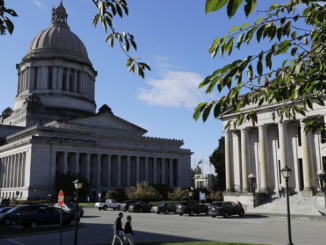
The eye-watering financial cost of the migrant crisis hit $150 billion last year and is causing devastating consequences for residents of hard-hit cities struggling to cope with the influx, The Post has learned.
{snip}
That has left huge holes in city budgets, meaning cutbacks for regular US citizens, including:
- Denver City Council has to cut $45 million from its budget, including $8.4m from it Police Department and $2.5m from the Fire Department to pay an estimated $90m bill for migrants.
- New York City is spending $2.3 billion in costs for housing migrants alone in 2023 and 2024, resulting in city agencies having to cut costs by 5%.
- In South Portland, Maine, property taxes have increased to pay for the migrant crisis and the mayor has advised elderly residents to re-mortgage their houses to pay them
- Chicago faces a $1 billion budget gap, partly over migrant services, which it is now scrambling to make up.
FAIR estimates there were at least 15.5 million “illegal alien residents” in the country at the beginning of 2022, with federal funding amounting to $3,187 per migrant per year, an increase of 45% since their last survey in 2017.
Of the federal government’s $67 billion spent in 2023, more than $6.6 billion was earmarked for education and over $25 billion was doled out in medical costs. Federal welfare programs ate up $11.5 billion and law enforcement costs were $23.1 billion, according to the 91-page “The Fiscal Burden of Illegal Immigration on United States Taxpayers 2023” report from FAIR.
{snip}
But because each state, city and county approaches migrant relief differently it is hard to estimate the full cost per migrant. However, the struggles certain communities face help show how much havoc the crisis is wreaking on ordinary citizens.
In New York City more than 210,000 migrants have traveled to the city since the spring of 2022. As The Post has reported, under the sanctuary city’s “right to shelter” policy 150 hotels are currently providing food and rooms for the migrants, who receive between 30 and 60 days of free housing with laundry facilities and help with childcare.
The overall costs to house asylum seekers per night is $352 and spending for 2023 and 2024 is set to surpass a staggering $2.3 billion.
To pay for it Mayor Eric Adams announced budget cuts at the end of 2023 of 5% across all city agencies.
{snip}
Funding for some of those ventures is expected to be restored in 2025.
New York City did receive aid through the Federal Emergency Management Agency (FEMA), which started a Shelter and Services Program in fiscal 2023 to address the migrant surge.
The agency allocated $640 million in fiscal 2024 for migrants, of which $81m went to New York City, by far the largest share given to any one place.
Another $23 million of the FEMA cash was given to authorities and non-governmental organizations in Denver — however, it falls far short of the amount required.
The city of 715,000 has received the largest influx of migrants after New York City, Chicago and San Diego, according to immigration data, with an influx of 42,000 migrants since December 2022.
Denver has already spent $70 million on caring for those migrants and introduced an initiative to spend another $90 million in April this year, according to local reports.
{snip}
“Denver City Council faced a requested $45 million cut, $17 million of which came from public safety agencies including Denver Police Department ($8.4 million) and Denver Fire Department ($2. 5 million),” according to a report on its website.
The Denver Asylum Seekers Program provides up to six months of rent free housing, assistance with food and legal issues, such as asylum applications and work permits.
The city, which rented out several hotels to deal with the surge of migrants, also works with non-profits to provide classes in English language, financial literacy and workers’ rights, according to reports. The city project $51.7 million in migrant housing costs alone in 2024, with another $9.7 million allocated to workforce training.
Supporters of the Asylum Seekers Program, which has spots for 1,000 participants, say that it will help migrants integrate into the local economy and the workforce much faster. The city estimates it costs $1,700 per migrant.
In Chicago, mayor Brandon Johnson announced in August the city has a $982m projected budget gap for 2025. Between 2022 and 2024 the city has spent over $400 million on migrants, according to NBC, with $141m spent this year, according to local site WTTW. The issue has been particularly contentious among residents and the city has since announced that by next year it will shut down its migrant shelter program and wrap it into a more “cost-effective” approach, rolling into its homelessness program.
{snip}
“I know it’s an ugly word,” he said at a city council meeting in August, “but there are — I’m just saying, I know it’s horrible, but it’s sort of a last resort.”
The reverse mortgage suggestion came at the same time that the city voted to allocate $1.9 million in its 2025 budget for migrants. The cash is slated for “General Assistance Vouchers” for asylum seekers’ rent, food and prescription drugs.
That’s ten times more than the $100,000 the City Council approved for their Senior Property Tax Relief Fund, according to reports.
“Food costs have increased and Asylum Seekers rely on General Assistance for food assistance,” the city’s budget reads, in part justification for the outlay.
Pride, an attorney who is up for re-election, walked back his comments earlier this month in a letter to the editor of the Portland Press Herald.
“It was an inappropriate remark … I never meant to advocate it as a general approach,” he wrote.
In June 2023, the city entered a 12-month contract to house migrants at the Howard Johnson hotel.
{snip}
Other small cities aren’t as lucky and are begging for federal funds after they have been overwhelmed with migrants. In Logansport, Indiana, a city of 18,000 residents, nearly 2,000 migrants — most of them unaccompanied minors — have put a strain on local schools.
Haitian migrant students have swelled from 14 in 2021 to 207 this year, according to reports.
“The federal government has got to step in and help communities our size,” Mayor Chris Martin recently told FOX 59 Indianapolis.
Local residents in the city, 90 miles outside Indianapolis, say they no longer feel safe in the community and their children are being muscled out of the public schools by recent arrivals who do not speak English and need a great deal of help from teachers.
{snip}
“What makes this Biden-Harris botched response unique—and particularly outrageous—is that the same administration claiming it doesn’t have enough money to support suffering Americans appropriated $1.6 billion dollars in FEMA funds to assist illegal aliens since October 2021,” said Kevin Roberts, Heritage Fund president in an article on the conservative think tank’s website.
* Original Article:
https://nypost.com/2024/10/23/us-news/migrant-crisis-cost-150bn-in-2023-local-towns-cutting-costs-to-cope/?utm_source=smartnews&utm_campaign=nypost&utm_medium=referral


